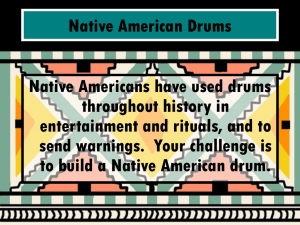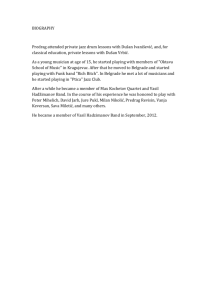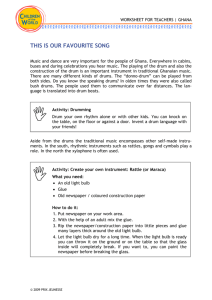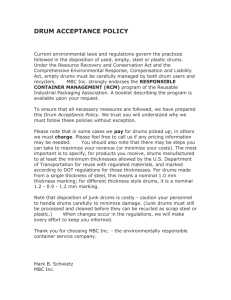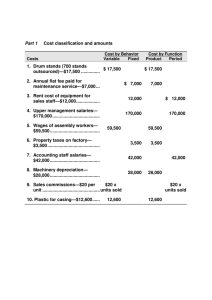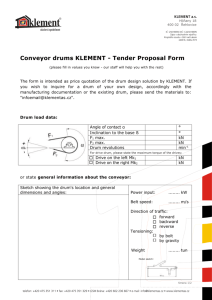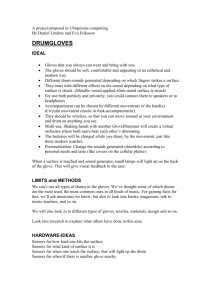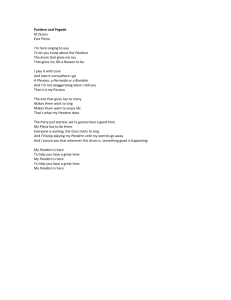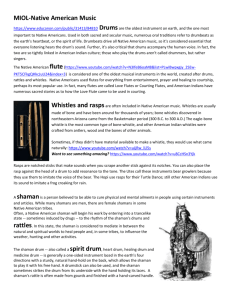My drum - Athens Education
advertisement
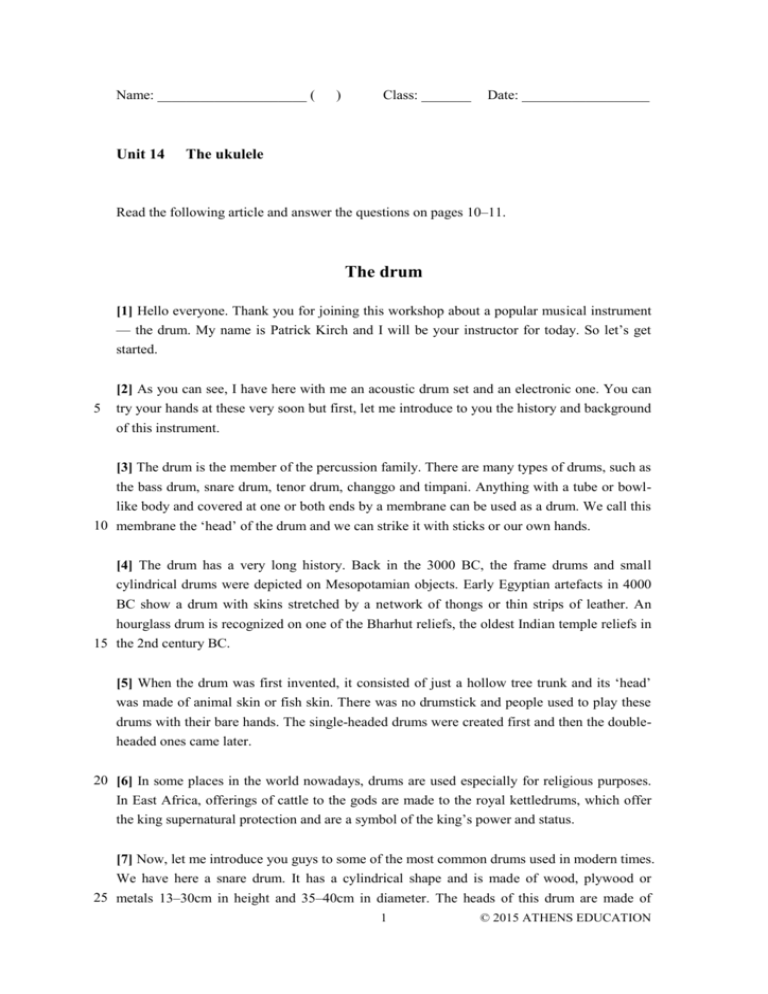
Name: _____________________ ( Unit 14 ) Class: _______ Date: __________________ The ukulele Read the following article and answer the questions on pages 10–11. The drum [1] Hello everyone. Thank you for joining this workshop about a popular musical instrument — the drum. My name is Patrick Kirch and I will be your instructor for today. So let’s get started. 5 [2] As you can see, I have here with me an acoustic drum set and an electronic one. You can try your hands at these very soon but first, let me introduce to you the history and background of this instrument. [3] The drum is the member of the percussion family. There are many types of drums, such as the bass drum, snare drum, tenor drum, changgo and timpani. Anything with a tube or bowl- like body and covered at one or both ends by a membrane can be used as a drum. We call this 10 membrane the ‘head’ of the drum and we can strike it with sticks or our own hands. [4] The drum has a very long history. Back in the 3000 BC, the frame drums and small cylindrical drums were depicted on Mesopotamian objects. Early Egyptian artefacts in 4000 BC show a drum with skins stretched by a network of thongs or thin strips of leather. An hourglass drum is recognized on one of the Bharhut reliefs, the oldest Indian temple reliefs in 15 the 2nd century BC. [5] When the drum was first invented, it consisted of just a hollow tree trunk and its ‘head’ was made of animal skin or fish skin. There was no drumstick and people used to play these drums with their bare hands. The single-headed drums were created first and then the doubleheaded ones came later. 20 [6] In some places in the world nowadays, drums are used especially for religious purposes. In East Africa, offerings of cattle to the gods are made to the royal kettledrums, which offer the king supernatural protection and are a symbol of the king’s power and status. [7] Now, let me introduce you guys to some of the most common drums used in modern times. We have here a snare drum. It has a cylindrical shape and is made of wood, plywood or 25 metals 13–30cm in height and 35–40cm in diameter. The heads of this drum are made of 1 © 2015 ATHENS EDUCATION Worksheets for Extensive Reading calfskin or plastic. Next to the snare drum is the tenor drum. It is also cylindrical in shape but larger and deeper toned than the snare drum. It is about 35cm in height and 45cm in diameter. We use two soft-headed stick to beat the tenor, and two tapered sticks ending in small knobs of wood or nylon for the snare. 30 [8] Why don’t we move on to the electronic drums now? They are more widely used today in Hong Kong because they are not as loud as the acoustic drum sets. Drummers can put on headphones to practise at home without annoying their family members. They are also lighter and easier to transport so it’s very convenient for the owners. However, there are several drawbacks to this electronic instrument. They are more expensive than their acoustic 35 counterparts, so young people like you may not be able to afford them. Moreover, because they are powered by electricity, there must be at least one power outlet and amplifier for drummers to hear their own tunes. [9] I hope you find this introduction useful and are inspired to become a drummer in the future. Don’t be scared by the expensive cost of a drum kit. There are many places in Hong 40 Kong where you can rent a studio for a whole day to practise your drum skills. But please remember that if you want to progress, you must practise regularly. Indeed, it is true for any musical instrument: if you don’t practise, you can never really play anything. Thank you very much and please come over here and try these drums. 2 © 2015 ATHENS EDUCATION 1. What are the purposes of the first paragraph? ________________________________________________________________________ 2. What does ‘acoustic’ (line 3) mean? ________________________________________________________________________ 3. According to paragraph 3, what is the normal appearance of a drum? ________________________________________________________________________ 4. How are drums played? ________________________________________________________________________ 5. How can we know about the history of the drums? ________________________________________________________________________ ________________________________________________________________________ 6. Find a word in paragraph 5 that means ‘empty’. ________________________________________________________________________ 7. What is the main idea of paragraph 5? A. How ancient people entertain themselves B. An introduction of drums made in the old days A B C D C. The limited resources ancient people had D. The materials of the drums 8. Apart from entertainment purpose, what is another purpose of drums? Explain your answer. ________________________________________________________________________ ________________________________________________________________________ 9. What are the two kinds of drums commonly used in modern days? ________________________________________________________________________ 3 © 2015 ATHENS EDUCATION Worksheets for Extensive Reading 10. What are the differences between the two drums in question 9? ________________________________________________________________________ ________________________________________________________________________ ________________________________________________________________________ 11. Decide whether the following statements are True, False or the information is Not Given. Blacken ONE circle only for each statement. T F NG i) The electronic drums are harder to play than the acoustic ones. ii) The acoustic drums are more expensive than the electronic ones. iii) The acoustic drums make less noise than the electronic ones. iv) The electronic drums are easier to carry than the acoustic ones. v) The electronic drums require a power outlet. 12. Who are the audience of the presentation by Patrick Kirch? ________________________________________________________________________ 13. Why did Kirch tell the audience not to worry about the cost of a drum kit? ________________________________________________________________________ 14. What was the advice Kirch gave to his audience? ________________________________________________________________________ 15. What is the tone of Kirch in paragraph 9? A. threatening B. calm C. encouraging A B C D D. serious 16. If you are the audience, will be interested in learning the drum? Use the information in the text to support your reason. ________________________________________________________________________ ________________________________________________________________________ 4 © 2015 ATHENS EDUCATION The drum Answer Key 1. To introduce the speaker and the topic 2. Able to function without an electronic source 3. The drum is anything with a tube or bowl-like body and covered at one or both ends by a membrane. 4. By hands or sticks 5. Through observing the ancient artefacts. For example, the frame drums and small cylindrical drums were depicted on Mesopotamian objects in the 3000 BC and an hourglass drum is recognized on one of the Bharhut reliefs, the oldest Indian temple reliefs in the 2nd century BC. 6. hollow 7. B 8. The drums are used for religious purpose. In East Africa, offerings of cattle to the gods are made to the royal kettledrums, which offer the king supernatural protection and are a symbol of the king’s power and status. 9. The snare drum and the tenor drum 10. The tenor drum is larger and deeper toned than the snare drum. Also, we use two softheaded stick to beat the tenor while two tapered sticks ending in small knobs of wood or nylon are used for the snare. 11. i) NG ii) F iii) F iv) T v) T 12. young people 13. It is because there are many places in Hong Kong where young people can rent a studio for a whole day to practise their drum skills. 14. Kirch advised his audience to practise their drums regularly. 15. C 16. (Open-ended. For example, ‘Yes, I will because they are popular musical instruments around the world. / No, I won’t because I don’t have time for regular practices.) 5 © 2015 ATHENS EDUCATION
